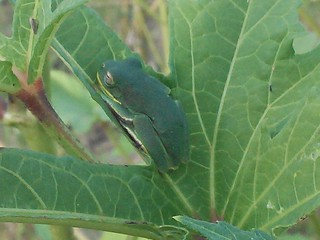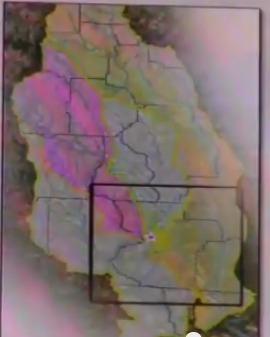 In what category does Georgia rank highest
In what category does Georgia rank highest
- for species diversity: plants, mammals, birds, reptiles, amphibians, or fishes?
- and in which of these four categories: diversity, risk, endemism (distinctiveness of species), and extincions?
Guess first, then look (no peeking)….
According to States of the Union: Ranking America’s Biodiversity, April 2002, by NatureServe for The Nature Conservancy. the answers are:
-
Amphibians, such as that tree frog sleeping in the okra. North Carolina ranks first, then Georgia, Virginia, Tennessee, and Texas.
Followed by fishes. Alabama has the most fish species, then Tennessee, Georgia, Kentucky, and Mississippi. (See Table 3 on Page 8.)
- Extinctions: Hawaii is first, followed by Alabama, California, Texas, and Georgia. (See Table 2 on Page 7.)
Notice which neighboring state comes ahead of Georgia in two of those lists: Alabama.
I found this report in an article sent by Bob Hastings, President of Sierra Club’s Alabama chapter. Daniel Cusick wrote for E&E News 21 July 2014, Ala. scientists warn of major loss in biodiversity, a message that’s not popular,
But the biggest challenge for the state’s biologists, ecologists, botanists and other natural resource specialists lies not with Alabama’s 137 endangered and threatened species — the third-highest number among the states — or the fragile and often postage-stamp-sized ecosystems those animals and plants inhabit.
It rests squarely in the capital, Montgomery, and the economic hubs of Birmingham, Mobile and Huntsville, where the state’s leaders have determined that climate change, arguably the world’s most pressing environmental concern, does not much apply to the Heart of Dixie.
“We’re kind of in this zone where we have climate forces battling, from the interior parts of the state to the Gulf Coast,” said R. Scot Duncan, a biologist and associate professor at Birmingham-Southern College, whose campus occupies a leafy hilltop tucked between this city’s downtown district and the gritty steel mills of nearby Fairfield and Bessemer.
“How that battle plays out will have a lot to say about how these ecosystems function in the future,” he added.
 The issues are similar in Georgia (and Florida).
These state governments have reduced funding for environmental protection,
and aren’t thinking ahead much about what will happen as the climate gets weirder.
It’s true the Suwannee-Satilla Regional Water Planning Council
considered climate change when it
met in May in Valdosta.
But it only had funding to do a one-shot report.
The issues are similar in Georgia (and Florida).
These state governments have reduced funding for environmental protection,
and aren’t thinking ahead much about what will happen as the climate gets weirder.
It’s true the Suwannee-Satilla Regional Water Planning Council
considered climate change when it
met in May in Valdosta.
But it only had funding to do a one-shot report.
Georgia had a State Climatologist, Dr. David Stooksbury, who straightforwardly said the climate is changing and humans are causing it about that. But he was removed from his post in 2011 by Gov. Nathan Deal. Deal made the head of GA EPD’s Meteorology Unit, Bill Murphey, the State Climatologist instead. And unsurprisingly Murphey’s public statements sound more like weather reporting. And Deal and the GA legislature also cut GA EPD’s budget.
The opposite is what’s needed. Georgia State University research shows that environmental protection can help reduce poverty.
 Weirder weather caused by climate change means more droughts,
such as the one that
the pine beetles took advantage of to breed
and kill this longleaf pine tree.
Higher temperatures mean
more and faster tree deaths,
and forestry is Georgia’s second largest industry,
with forests worth even more in ecosystem services.
Weirder weather caused by climate change means more droughts,
such as the one that
the pine beetles took advantage of to breed
and kill this longleaf pine tree.
Higher temperatures mean
more and faster tree deaths,
and forestry is Georgia’s second largest industry,
with forests worth even more in ecosystem services.
After the floods of 2009 and 2013, it’s great that Valdosta has called in the U.S. Army Corps of Engineers who may now start a serious flooding study for the entire Suwannee River Basin. Insurance companies, which can’t afford to doubt the evidence of climate change because much of it appears as rapidly-increasing insurance claims, may sue local governments that don’t prepare for climate change. That 2009 flood was not due to a record rain. The more likely culprits include too much clearcutting and too much impermeable cover such as parking lots and roads. But what will happen when we get a record rain on top of those other problems?
 And those same other problems (clearcutting, impermeable surface)
plus agrochemicals and others, contribute to species risk and extinctions.
According to that NatureServe report,
Georgia is number 6 for species diversity,
and number 8 for species risk.
Georgia is only number 12 for endemism (distintiveness of species),
possibly because it’s number 5 for extinctions.
Maybe the dying amphibians are the canary in Georgia’s gold mine
of species diversity.
And those same other problems (clearcutting, impermeable surface)
plus agrochemicals and others, contribute to species risk and extinctions.
According to that NatureServe report,
Georgia is number 6 for species diversity,
and number 8 for species risk.
Georgia is only number 12 for endemism (distintiveness of species),
possibly because it’s number 5 for extinctions.
Maybe the dying amphibians are the canary in Georgia’s gold mine
of species diversity.
For more about species, see also the interactive online NatureServe Explorer.
-jsq
Short Link: